A muscle pump is by far the most sought after and most talked-about condition of resistance training and bodybuilding. Everyone loves a good pump and will do whatever it takes to get there.
When you’ve been lifting weights for as long as I have, you’ve heard just about every trick in the book. And trust me I have. But I have also learned over the years what works and what doesn’t work.
If you have a short moment and are serious about getting your pump on, then you’ll want to keep reading. I know what it takes to get a good pump, and can guarantee that I personally practice all of these methods myself, and have done so for many years.
You also will not want to miss my “Muscle Pump Of The Month Video” demonstrating some exercise routines that will set your muscles on fire and create mind-blowing pumps!
So without me boring you any further, let’s get started.
TABLE OF CONTENTS
- What Is A Muscle Pump Anyway?
- Reasons Why Muscle Pumps Are Important
- Muscle Pump Of The Month Video
- Trashing Triceps
- Nasty Biceps Pump
- Shoulder Destroyer
- 12 Muscle Pump Tips & Tricks That Guarantee Explosive Pumps
- Muscle Pump FAQ
- Closing Remarks
What Is A Muscle Pump Anyway?
A good muscle pump is when you can force as much blood as humanly possible into any given muscle group while performing resistance type training.
In short, and without getting too technical, muscle pumps are generated under intense workout conditions whereby a muscle group expands and contracts repeatedly. As a result, the vascular system pushed more blood into the target muscle area in order to provide more oxygen and nutrients for energy. But there is more.
With this increased need for more nutrients and oxygen, the vascular system now sends a compound called nitric oxide to the muscles. Nitric Oxide helps widen the arteries which allow even more blood to enter – a process known as vasodilation.
Now let’s see how this can benefit your workout.
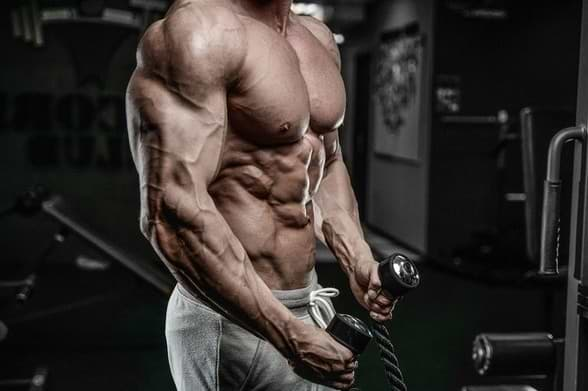
Reasons Why Muscle Pumps Are Important
Muscle pumps can be beneficial to your workout regimen for many reasons.
First and foremost, the psychological effect it has greatly increases your motivation and energy.
Keeps You Coming Back For More
The feel-good hormones released under these conditions are chemicals called endorphins. Endorphins give you that euphoric high feeling while working out. But even more so when your muscles are pumped to the max.
You’ll notice how your energy and enthusiasm spikes when you get that pump. It makes you look good. It makes you feel good. It makes you want to keep going and going.
So if anything, the psychological effect will keep you working out longer and more intensely, and will also keep you coming back for more.
Stimulates Muscle Growth
Secondly, a good pump is usually a good indicator that you have had a successful workout and that you have pushed copious amounts of blood into the muscle.
Why is this good? Well, because all this blood is carrying not only oxygen but also very important nutrients to the muscles that are beneficial for growth.
Though muscle pumps may not always be necessary for muscle growth, they are nevertheless an important factor in stimulating growth nonetheless. Additionally, the intensity required to achieve these pumps will without a doubt also result in improved muscle definition and muscle vascularity.
Muscle Pump Of The Month Video
Every month you will find a new video I have personally hand-picked to add to my “Pump Of The Month Video” segment. I will personally try each workout, and add my short commentary with my evaluation and experience for each video. So make sure to come back each month to find a new video and join me in the fun.
In our first video, by Animal, you will see Evan Centopani show you how he incorporates the superset into his triceps routine (pay special attention to the first 6 minutes of this video where he demonstrates 2 triceps pushdown exercises). What caught my attention was the fact that he suggested flaring the elbows out on the straight bar cable pushdown machine.
I have always been instructed to keep the elbows in, and thus have been doing so for many years. So how could I not give this a go, especially coming from someone as accomplished and well known as Evan?
#1 Trashing Triceps!
So I gave this routine a try, and I must say I was pleasantly surprised with the results.
Wow! Talk about a pump!
I absolutely loved the advice on how to position your hands on the rope and the elbow position for the straight bar cable pushdowns. The stretch and the burn I felt at the top of the straight bar cable pushdown was absolutely agonizing, to say the least. But in a tremendously good way!
I absolutely recommend this routine to anyone who wants to experience a mind-blowing triceps pump. Thanks, Evan for such an awesome video.
#2 Nasty Biceps Pump!
John Meadows has always been one of my go-to guys for learning new tricks. In the following video watch a routine John created that will absolutely destroy your biceps and give you a pump to remember!
#3 Shoulder Destroyer – Finisher
I’ve been following Dana Linn Bailey for many years. And I can tell you when it comes to workout intensity, Dana is the master. The following is about a 15-minute routine that will absolutely pump your shoulders to the max. If you want to bypass her workout instructions and go straight to the routine, then fast forward to 6:55 minutes.
Basically, what you will see is her “giant set” which includes 5 different exercises. You will perform this giant set 3 times for a total of approximately 15 minutes. You can perform this at the end of your normal shoulder workout routine, or as a complete workout if you are short on time.
12 Muscle Pump Tips & Tricks That Guarantee Explosive Pumps
Here are my top 12 tips you should follow in order to guarantee a muscle pump on your next workout. Some of these tips may seem pretty obvious at first glance, but you’d be surprised how many people still forget. Yes, we all have short memories.
Nonetheless, I’m sure you will benefit from all and will more than likely even find 1 or 2 new tricks you’ve never heard of before now.
#1 Make Sure You’re Hydrated
Probably one of the most obvious but also the most overlooked is hydration. Many of you believe you are hydrated enough when hitting the gym when in actuality you are not. Taking water to the gym and drinking while you workout is not a guarantee that you are fully hydrated.
To make sure you are hydrated enough, you should have already been drinking plenty of water before you even entered the gym. Or if working out at home, then well in advance of your workout session.
Just like the rest of your body, your muscles store water and require water to function. If you are not hydrated, your muscle pump will suffer.
#2 Carb Up!
Another big mistake and something I had not learned about until many years after I started weight training, was that not having enough carbs can prevent a good pump and leave you flat no matter how hard you train. Or at least kill a good pump very quickly.
Just like water, carbohydrates are necessary for a good pump. Carbs are converted to glycogen, which like water is then stored in the muscles. Glycogen is used as energy to fuel your workout.
When glycogen levels are depleted your body turns to your muscles for glycogen. Unfortunately, this can lead to a catabolic state rather than anabolic. A place you do not want to be in when muscle training.
That said, if your glycogen levels are low to none before a workout, then muscle pumps will be pretty much impossible. And if your glycogen levels are normal but you still tend to lose your pump after about 30-60 minutes of intense training, it is because of glycogen depletion. This is normal. This can be fixed with a simple carb drink while you are working out.
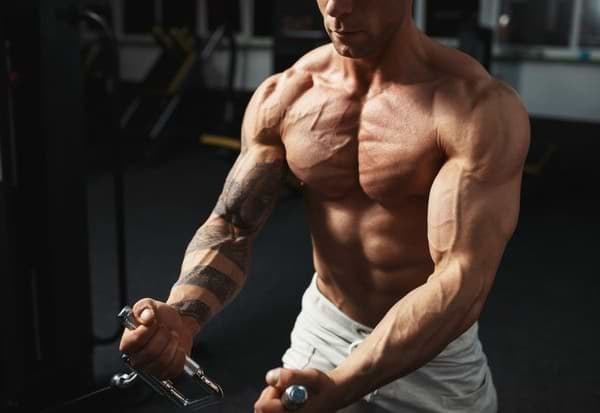
#3 Stretching Between Sets
Now stretching is one of those tricks that can transform a good muscle pump into a massive mind-blowing super-pump! Occasionally I will incorporate these into my biceps or triceps exercise and get a monster pump from hell.
Perform stretches once or twice (no more or it could affect your strength level in a negative way) between sets for each arm during your exercise. Each stretch should be at least a good 20-30 seconds long.
For biceps, I like to hold a bar, keeping my arm straight, and gradually rotate my body away so my arm is then slightly behind me. Once you feel the stretch in your bicep, hold that position for 20-30 seconds. Trust me it will burn. Then continue with your exercise.
For triceps, curl your arm like your doing a biceps dumbbell curl, raise your arm up so your elbow is now over your head and push it up against a wall or solid object. The harder you push the more it will stretch. Again, hold it for 20-30 seconds.
By doing this between sets, you are stretching the muscle fibers which fill with blood. This, in turn, lets more blood fill these cells and as a result, creates a bigger and better pump than you can imagine.
#4 Muscle Pump Supplements
I have tried numerous brands and types of supplements, but currently, only use one. Which I will get to in a moment.
Probably one of the more popular supplements for energy, strength, and muscle fullness, is creatine monohydrate. This supplement allows your muscles to hold more water. I do not find creatine to be a big factor for muscle pumps, but it can help.
Nitric Oxide Boosters, on the other hand, can be very effective at increasing muscle pumps. As we read earlier, nitric oxide allows the blood vessels to widen and allow more blood flow into the muscles.
There are many Nitric Oxide Boosters available on the market. Most are a bit overpriced and include both L-Arginine and L-Citrulline as their main ingredients.
It is probably more cost-effective to purchase these amino acids separately as you will get more milligrams for your money.
I personally have had much success using only the L-Citrulline supplement. I get a better pump and it helps make my pumps last longer. I usually take about 2-3 mg before a workout.
There are 2 types of Citrulline: L-Citrulline and Citrulline Malate. You will find many arguments for and against which is better and more effective. After doing my own research, I decided the L-Citrulline is just as effective – and cheaper.
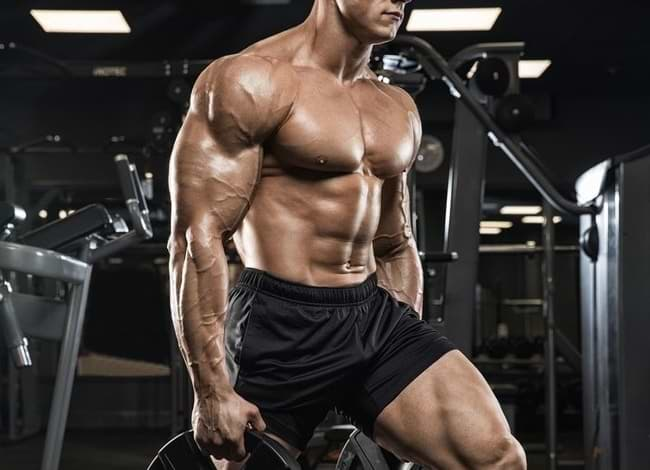
#5 Constant Tension
Your goal here is to keep constant tension on the muscles being worked. Never rest the wait at the bottom or top of the exercise. Always keep the weight moving. Speed is not necessarily a factor here, but rather a nonstop smooth and consistent gliding. Somewhat like a steady rhythmic motion, or almost robotic in tempo.
#6 Short Rest Periods
Another great and effective way to pump up your muscles is by taking shorter rest periods between sets. If you are typically taking between 30-60 minute rests, try reducing that time by half. And half that again if necessary.
#7 Blood Flow Restriction Bands
BFR training, also known as occlusion training, is something I learned about a few years ago. After some extensive research of my own, I decided to try it myself and invested in a pair of BFR Bands. This technique uses BFR Bands to restrict blood flow which results in occlusion.
This causes blood pooling in the muscles being worked. Basically blood is being pushed into the muscles faster than it can be returned. This occlusion effect can cause great muscle pumps without using heavy weights. I mostly use this technique if I don’t have access to heavy weights, or when I am suffering joint pain.
You can learn more about occlusion and BFR Training here.
#8 Mind-To-Muscle Connection
If you’re going to the gym and moving weights while looking around the room, you’re probably not getting the full benefit of lifting weights. It is absolutely imperative that you concentrate on every movement, positive and negative, and that you feel your muscles contract.
If you don’t feel your muscles burning, you’re not connecting with your muscles. This means you’re not activating the muscles effectively. To get a better mind-to-muscle connection, try to slow down your execution, or drop the amount of weight you are lifting.
Sometimes just going through the motions with a super light weight, and feeling your muscles contract and expand, will give you a better mind-to-muscle connection before starting your exercise.
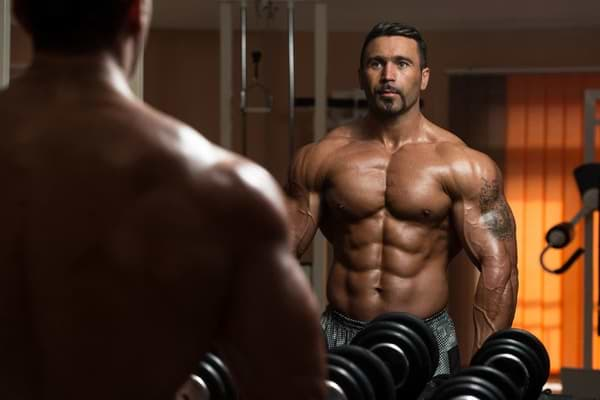
#9 Forced Reps
If you think doing 4-5 sets of 8-10 reps is enough, you would be wrong. Every set that you perform must be taken to the limit. You must squeeze out as many reps as you possibly can. When they say no pain no gain…this is the time to practice it. This means taking every set to failure.
When you think you’ve done your last rep, take a 2-3 second breather and do another rep. When you can no longer do another forced rep, try doing a few more partial forced reps. This means only performing half the range of motion.
#10 Drop Sets
Drop sets are great to perform on the last few sets of your last exercise. This technique will burn out your muscles but also generate an extremely good pump. So I prefer doing this last.
I like using dumbbells for this technique. Starting with a weight I can do 8-12 reps with, I will complete that set and immediately drop the weight 5lbs and do a max set, followed by another max set, and keep going until I can no longer do another rep. The trick here is not to rest between sets, and always do the maximum number of reps you can squeeze out of each set.
#11 Supersets
Supersets are my favorite and most used technique for getting awesome pumps. I like doing these with opposing muscle groups such as biceps and triceps, or with the same muscle group. I even get a good pump doing shoulders and back combo.
Basically, with supersets, you perform one set to completion and then immediately go to a second exercise. When doing this with the same muscle group, biceps for example, I will do a straight biceps curl followed by a dumbbell curl.
These without fail give me a tremendous pump every time. You should definitely give these a try.
#12 Proper Form
Targeting the muscle properly and activating the muscle fibers effectively is paramount for getting the maximum muscle pump possible. If you are not getting a good pump, here are some things you can do to correct your form:
- Drop the weight and concentrate more on your movement and the muscles worked and less on the amount of weight your moving.
- Slow down your exercise and concentrate more on the muscles. This will help you better connect the weight with the muscles being worked.
- Concentrate on the muscle contraction, but also concentrate on the negative movement. Never drop the weight on the negative. The negative is just as important as the positive motion for any exercise. I see far too many people dropping the weight on the negative. This, to me, is like wasting half the exercise. So keep your muscles engaged and tense throughout the entire movement.
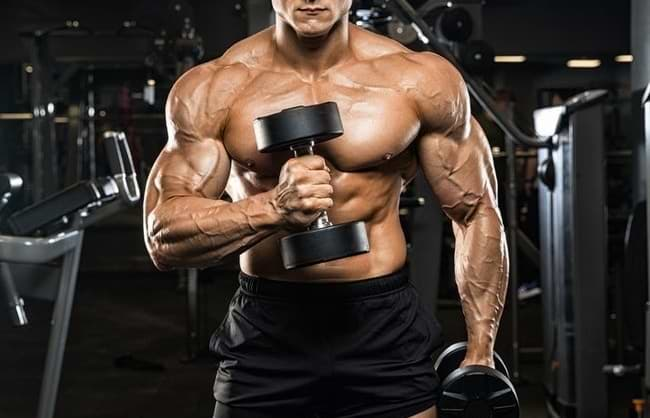
Muscle Pump FAQ
No matter how hard I work out, I cannot get a pump. Can you help?
There is no one answer to this, but I have learned that in most cases it is due to lack of glycogen in the muscles. This is why I suggest consuming a carb drink before or even during a workout session. Let me just give you my personal experience before getting scientific with this.
I had at one time decided to go on a low carb to almost zero carb diet to cut body fat. Well, I can tell you with certainty, that no carbs and pumps can not co-exist. After about 2 weeks, I was getting only half the pump I normally would. And after 2 weeks it was impossible for me to get any degree of muscle pump whatsoever. No matter how hard I tried, none of the techniques I listed above worked.
After about 3 days of carbing up again, I was finally back to my normal self and getting mind-blowing pumps again. Let me tell you, there is nothing worse than workout your tail end off at the gym and not feeling even the slightest pump.
So, if you’re low on carbs, that could be your problem.
How can I make my pump last longer after my workout?
I have found that 3 of the most effective ways to make pumps last longer after a workout is to drink a lot of water after my workout, have a carb drink after my workout, and take more L-Citrulline. A minute of posing and contracting the muscles will also help keep the blood flowing longer.
Are muscle pumps necessary for muscle growth?
I believe every workout should result in some degree of muscle pump. However, I don’t believe you should be chasing pumps every workout session. Using all the techniques above to generate super pumps is a good way to stimulate growth and add size and definition. However, you must also dedicate enough time to heavy weight training to add size.
These heavier workout sessions will not always create super pumps, but should still create a pump nonetheless. If you’re not getting any degree of muscle pump when lifting heavy, then you may be doing something wrong. In most cases I’ve seen, it’s due to lifting too heavy and sacrificing form.
When you sacrifice form, you let supporting muscles and joints take over the exercise. This results in less of the targeted muscle being engaged in the exercise. In this case, drop the weight, correct your form, and concentrate on using your target muscle for better muscle activation.
What are the best supplements to maximize muscle pumps?
I have used many different muscle pump products and nitric oxide boosters over the years. They tend to be the best supplements to use for greater pumps at the gym. The nitric oxide booster’s main ingredients include both the amino L-Arginine and L-Citrulline. I personally like using pure L-Citrulline as it is just as effective and costs less.
Should I be getting a muscle pump when training heavy for size?
You should definitely see a degree of muscle pump even when you are training heavy. It will most likely not be the mind-blowing pumps you would achieve using the methods outlined above, such as higher reps, drop sets, forced reps, etc.
If you are not experiencing any pump at all, then your joints and supporting muscles may be taking over part of the load. This is due to bad form, which is usually the case if you are lifting too heavy.
To correct this, drop the weight and pay close attention to your form. Make a mind to muscle connection by concentrating on using only the muscles you are targeting. This will significantly increase the engagement and blood flow of the targeted muscles.
Can I use these muscle pump techniques for legs and glutes?
Yes, absolutely. I myself have even tried the stretching technique on glutes, which was very effective. Basically, I would do a few sets of walking lunges, followed by some glute stretching, and then immediately continue with my lunges. I can tell you, my glutes were pumped to the max!
How many sets should I do?
I typically do 4-5 working sets per exercise. And that does not include the 2 sets I use to warm up and push blood into the target muscles. If you are only doing 3 sets per exercise, then you are not doing enough.
Closing Remarks
The euphoric feeling you get from muscle pumps is extremely gratifying and the benefits numerous. If you’ve been having problems achieving muscle pumps in the past, this article will help you going forward.
I can’t tell how many times I’ve been asked over the years, how I get such an incredible pump. And I’m always eager to share my knowledge, knowing it will help.
Now that I have put this information on paper (or rather the internet), it’s pleasing to know that I can now reach out and help so many more people than just those at my gym.
I know this post has turned out rather lengthy. But if you’re anything like me, when your passionate about a certain subject, you enjoy taking in as much information as possible to reach your goal.
I hope you’ve enjoyed reading my article as much as I have enjoyed writing it. Feel free to share your experiences, thoughts, or questions in the comments section below. I look forward to hearing from you.

With over 30 years of experience in strength training and fitness, Mark LaRue is the founder of Fitness Mastered, a blog to help educate fitness enthusiasts of all fitness levels, ages, and gender. We write topics that range from weight training tips and exercise routines to home workout machine and fitness related product reviews, to name a few.

